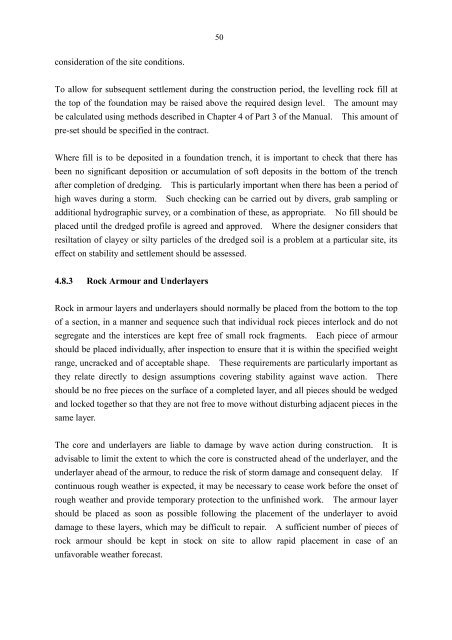Port Works Design Manual : Part 2
Port Works Design Manual : Part 2
Port Works Design Manual : Part 2
- No tags were found...
Create successful ePaper yourself
Turn your PDF publications into a flip-book with our unique Google optimized e-Paper software.
50consideration of the site conditions.To allow for subsequent settlement during the construction period, the levelling rock fill atthe top of the foundation may be raised above the required design level. The amount maybe calculated using methods described in Chapter 4 of <strong>Part</strong> 3 of the <strong>Manual</strong>. This amount ofpre-set should be specified in the contract.Where fill is to be deposited in a foundation trench, it is important to check that there hasbeen no significant deposition or accumulation of soft deposits in the bottom of the trenchafter completion of dredging. This is particularly important when there has been a period ofhigh waves during a storm. Such checking can be carried out by divers, grab sampling oradditional hydrographic survey, or a combination of these, as appropriate. No fill should beplaced until the dredged profile is agreed and approved. Where the designer considers thatresiltation of clayey or silty particles of the dredged soil is a problem at a particular site, itseffect on stability and settlement should be assessed.4.8.3 Rock Armour and UnderlayersRock in armour layers and underlayers should normally be placed from the bottom to the topof a section, in a manner and sequence such that individual rock pieces interlock and do notsegregate and the interstices are kept free of small rock fragments. Each piece of armourshould be placed individually, after inspection to ensure that it is within the specified weightrange, uncracked and of acceptable shape. These requirements are particularly important asthey relate directly to design assumptions covering stability against wave action. Thereshould be no free pieces on the surface of a completed layer, and all pieces should be wedgedand locked together so that they are not free to move without disturbing adjacent pieces in thesame layer.The core and underlayers are liable to damage by wave action during construction. It isadvisable to limit the extent to which the core is constructed ahead of the underlayer, and theunderlayer ahead of the armour, to reduce the risk of storm damage and consequent delay. Ifcontinuous rough weather is expected, it may be necessary to cease work before the onset ofrough weather and provide temporary protection to the unfinished work. The armour layershould be placed as soon as possible following the placement of the underlayer to avoiddamage to these layers, which may be difficult to repair. A sufficient number of pieces ofrock armour should be kept in stock on site to allow rapid placement in case of anunfavorable weather forecast.
















